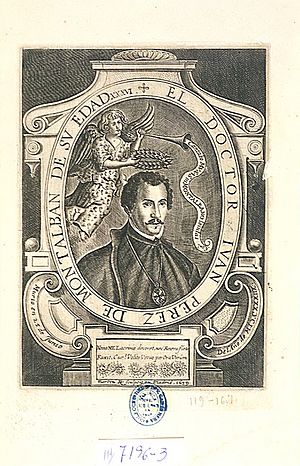Juan Pérez de Montalbán facts for kids
Juan Pérez de Montalbán (born 1602 – died June 25, 1638) was a Spanish Catholic priest, a writer of plays, a poet, and a novelist. He lived during a very exciting time for Spanish literature.
Biography
Juan Pérez de Montalbán was born in Madrid, Spain. When he was eighteen years old, he earned a special degree in theology, which is the study of religious beliefs. In 1625, he became a priest. He also worked as a notary for the Spanish Inquisition, which was a powerful religious court at the time.
He started writing plays in 1619. A famous writer named Lope de Vega helped him. It is believed that Lope de Vega even helped Montalbán write a long poem called El Orfeo en lengua castellana (published in 1624). This poem was likely written to compete with a similar poem by Jáuregui that came out earlier that year.
Montalbán's father was a publisher in Madrid. He released an unauthorized copy of a book by Quevedo called Buscón. This caused a big argument and many strong debates. The stress from these arguments, along with working too much and the death of his friend Lope de Vega, made Montalbán very ill mentally. He died in Madrid on June 25, 1638. His last work was a biography praising Lope de Vega, published in a collection called Fama póstuma (1636).
Works
Montalbán's plays were published between 1635 and 1638. They were all written in the style of Lope de Vega. His plays were very popular when they were performed. However, many of them, except for Los Amantes de Teruel, were seen as quick, creative plays rather than deeply planned ones. Montalbán wrote almost as many plays as Lope de Vega. But some critics felt he copied Lope de Vega's usual style too much, meaning his plays sometimes lacked strong plots or careful finishing.
His prose stories were also very popular. These included Sucesos y prodigios de amor, en ocho novelets ejemplares (1624) and Para todos: Exemplos morales, humanos y divinos (1632). A historian named George Ticknor said that "The Disastrous Friendship," a story from the first collection, was one of the best in the Spanish language. Another story, "Aurora and the Prince," was translated into English by Thomas Stanley in 1647.
A very critical written piece attacking Quevedo, called El Tribunal de la justa venganza (1635), is often thought to have been written by Montalbán. Montalbán was so well-known that sometimes his name was put on works written by other authors.
See also
 In Spanish: Juan Pérez de Montalbán para niños
In Spanish: Juan Pérez de Montalbán para niños


